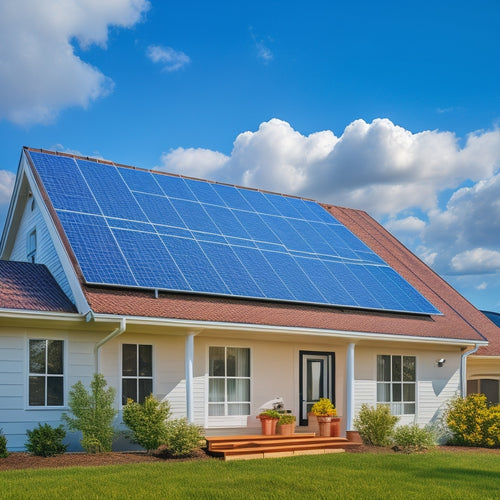
Solar Panels and Installation
Share
As you investigate solar panels and installation, you'll uncover the benefits of utilizing renewable energy. Advanced photovoltaic cell technology and bifacial panels enhance energy conversion rates, while grid integration and energy storage solutions guarantee consistent power availability. With reduced carbon footprint assured, you'll minimize fossil fuel reliance and lower emissions. Proper installation angles, orientations, and roof size considerations maximize energy output. Warranty and protection options provide security for your investment. Now that you've started to reveal the world of solar panels and installation, you'll likely want to delve deeper into the specifics that'll make your shift to clean energy a success.
The Essentials
- Higher energy conversion rates are achieved through advanced panel designs and photovoltaic cell technology, reducing fossil fuel reliance.
- Ideal tilt angles and orientation directions maximize solar energy output, with seasonal adjustments optimizing energy capture during summer and winter.
- Bifacial solar panels capture energy from both sides, boosting output, while monofacial panels require south-facing orientation for optimal output.
- Roof size and energy needs assessments are crucial for determining installation capacity, with usable surface area and daily energy consumption patterns influencing system choice.
- Extended warranties, typically covering performance, defects, and materials for up to 25 years, provide security for solar panel investment.
Higher Energy Conversion Rate
You're looking for solar panels that can efficiently harvest energy and produce maximum power output.
To achieve this, you need panels with a higher energy conversion rate, which is the ratio of output power to input solar irradiance. This is particularly essential in today's renewable energy environment, where photovoltaic cell technology plays a significant role in reducing our reliance on fossil fuels.
Efficient Energy Harvesting
Optimization in solar panel design has led to a significant surge in energy conversion rates, enabling efficient energy harvesting. As you investigate the world of solar energy, you'll find that advancements in panel design have dramatically improved energy output. This means you can capture more power from the sun, reducing your reliance on traditional energy sources.
Advancements in Solar Panel Technology have led to the development of more efficient photovoltaic cells, further increasing energy conversion rates. With the integration of state-of-the-art technology, solar panels can now generate more power per unit area than ever before.
When it comes to efficient energy harvesting, you'll want to evaluate energy storage solutions. By integrating energy storage systems, such as batteries, you can store excess energy generated during the day for use during the night or on cloudy days. This guarantees a consistent flow of power, giving you more control over your energy usage.
Grid integration is another vital aspect of efficient energy harvesting. By connecting your solar panel system to the grid, you can sell excess energy back to the utility company and offset your energy costs. This not only reduces your energy bills but also contributes to a cleaner, more sustainable energy environment.
With efficient energy harvesting, you're taking a significant step towards energy independence and a more sustainable future.
Maximum Power Output
With maximum power output being a crucial aspect of solar panel performance, it's essential to understand how advancements in technology have led to higher energy conversion rates.
You're likely aware that solar panels convert sunlight into electrical energy, but what you mightn't know is that the efficiency of this process depends on the panel technology used.
Modern solar panels boast higher solar efficiency due to improved manufacturing processes and innovative materials. For instance, bifacial solar panels can capture energy from both the front and back sides, increasing their overall energy output.
Furthermore, with the ability to go off-grid using Camper Solar Panel Kits, you can enjoy the freedom to camp anywhere while still having a reliable source of power.
Additionally, advancements in inverter technology have enabled more efficient conversion of DC power to AC power, further enhancing the maximum power output of your solar panel system.
Reduced Carbon Footprint Guaranteed
By switching to solar panels, you're opting for an eco-friendly energy source that greatly reduces your reliance on fossil fuels.
This means you'll be producing clean energy while minimizing your carbon footprint, which is an essential step towards mitigating climate change.
As you shift to renewable energy, you'll not only reduce your carbon footprint but also lower your energy bills.
With solar panels, you can expect lower emissions guaranteed, making it an attractive option for environmentally conscious individuals and businesses alike.
Eco-Friendly Energy Source
Renewable energy sources, such as solar power, are becoming increasingly essential in the modern era, as they offer a cleaner alternative to traditional fossil fuels. As you consider your energy options, you're likely drawn to solar innovations that provide renewable technologies and sustainable solutions.
You're not alone in seeking energy independence, and solar power can help you achieve that. By utilizing the sun's energy, you'll not only reduce your environmental footprint but also enjoy cost savings and grid alternatives.
You'll appreciate the benefits of energy storage, which allows you to store excess energy generated during the day for use at night or during power outages.
Policy support and community initiatives are also available to help you shift to solar power. With the right incentives and resources, you can join the growing number of individuals and businesses embracing eco-friendly energy sources.
Lower Emissions Guaranteed
You've made a conscious decision to reduce your reliance on fossil fuels and switch to solar power, and that's a noteworthy step in the right direction.
By installing solar panels, you're not only reducing your carbon footprint but also contributing to a cleaner environment. With solar power, you'll be generating clean energy and reducing your dependence on fossil fuels, which translates to lower emissions.
Solar panels guarantee a reduced carbon footprint, and that's not all. You'll also enjoy cost savings and financial incentives.
The initial investment in solar panels may seem steep, but the long-term benefits far outweigh the costs. You'll be reducing your energy bills considerably, and with net metering, you can even sell excess energy back to the grid.
Additionally, governments offer financial incentives, such as tax credits and rebates, to encourage the adoption of solar power.
Maximizing Energy Output Angles
You'll need to evaluate two essential factors to maximize your solar panels' energy output: ideal tilt angles and optimal orientation directions.
This is vital in ensuring a reliable off-grid energy solution, which is made possible by renewable energy systems that integrate solar power grid system technology.
The tilt angle affects how directly sunlight hits the panels, while the orientation direction influences the amount of energy generated throughout the day.
Optimal Tilt Angles
When it comes to maximizing energy output from your solar panels, getting the tilt angle just right is essential. The ideal tilt angle depends on your location's geographic variations, including latitude and local climate.
In general, a tilt angle equal to your latitude is a good starting point. However, you may need to adjust this angle seasonally to account for the sun's changing position in the sky.
During the summer months, a slightly shallower tilt angle can help maximize energy output. Conversely, a steeper tilt angle can help capture more energy during the winter months when the sun is lower in the sky.
You may need to make adjustments based on your location's unique conditions, such as shading from nearby trees or buildings.
Ideal Orientation Directions
Typically, solar panels are installed facing certain directions to maximize energy output. As you evaluate installing solar panels, it's crucial to understand the ideal orientation directions for your system. In the northern hemisphere, a south-facing orientation is ideal, as it receives the most direct sunlight throughout the day.
East- and west-facing orientations can also work well, but may not produce as much energy as a south-facing setup.
When determining the ideal orientation direction for your solar panels, you'll need to assess the type of solar panel and its installation costs. For example, bifacial solar panels can generate energy from both the front and back sides, making them a good option for east- or west-facing installations.
However, these panels may come at a higher cost. Monofacial solar panels, on the other hand, are more affordable but may require a south-facing orientation to maximize energy output.
Wattage for Your Roof
When determining the wattage for your roof, you need to take into account the size of your roof and how much energy you want to produce.
A larger roof can accommodate more solar panels, which translates to higher wattage, but you'll also need to factor in your energy output needs.
With residential solar panels being a key component of renewable energy systems, it's crucial to assess your energy requirements accurately.
Roof Size Considerations
Determining the ideal solar panel wattage for your roof involves calculating its usable surface area, taking into account obstacles and shading.
You'll need to assess your roof's size, shape, and orientation to determine the maximum amount of solar panels that can be installed. Different roof types, such as gable, hip, or flat roofs, will have varying amounts of usable space.
Additionally, you'll need to take into account obstacles like skylights, vents, and chimneys that may reduce the available area.
Shading effects from surrounding trees, buildings, or other structures can also impact the amount of sunlight your roof receives.
You'll need to factor in these shading effects to determine the best solar panel configuration for your roof.
Energy Output Needs
With your roof's usable surface area and shading effects accounted for, you're now ready to determine the energy output needs for your solar panel installation. This involves calculating the total wattage required to meet your energy demands. To do this, consider your energy usage patterns, including your daily energy requirements, energy storage needs, and system maintenance schedules.
| Energy Usage | Daily Energy Requirements | Recommended System Size |
|---|---|---|
| Low (1-2 people) | 10-20 kWh | 2-4 kW |
| Medium (3-5 people) | 20-40 kWh | 4-8 kW |
| High (6-10 people) | 40-80 kWh | 8-16 kW |
| Very High (>10 people) | 80-120 kWh | 16-24 kW |
| Commercial | Varies | Customized solution |
When selecting a system size, consider factors such as cost analysis, installation techniques, grid integration, and regulatory incentives. Financing options and performance monitoring capabilities should also be taken into account. Additionally, think about the environmental impact and technology advancements that can enhance your system's efficiency. By carefully evaluating these factors, you can determine the best energy output needs for your solar panel installation.
Longer Lifespan Warranty Offered
You're likely to benefit from extended product protection when choosing a solar panel system, as it provides an additional layer of security for your investment.
A longer lifespan warranty typically covers the panels' performance, defects, and materials for an extended period, usually up to 25 years or more.
This means you'll have peace of mind knowing that you're protected against potential issues that may arise during the system's operational lifetime.
Extended Product Protection
As you invest in solar panels, guaranteeing their longevity becomes a top priority. Extended product protection is a significant aspect to evaluate, providing you with peace of mind and financial security. This extended warranty option safeguards your investment by covering potential repairs, replacements, and maintenance costs for an extended period.
When assessing extended product protection, analyze the installation techniques used, as these can impact product durability. Review the maintenance schedules recommended by the manufacturer and the warranty options available. Confirm the system integration is seamless, and insurance coverage is sufficient.
Performance monitoring is also important to identify potential issues early on. Financing options for extended product protection vary, so it's crucial to weigh the costs against the benefits. Reflect on the environmental impact of your solar panels and the long-term savings they provide.
Frequently Asked Questions
Can Solar Panels Be Installed on a Metal Roof?
When exploring eco-friendly upgrades, you'll find that metal roofs offer advantages, but installing solar panels on them presents unique challenges, requiring specialized mounting systems and careful planning to guarantee a secure, watertight fit.
How Often Should Solar Panels Be Cleaned?
You'll want to clean your solar panels regularly to maintain ideal energy output; aim for every 6-12 months, depending on your location's climate and pollution levels, to guarantee efficient solar panel maintenance and maximize your energy independence.
Do Solar Panels Work During a Power Outage?
When the grid goes dark, do you stay in the dark too? Not if you're prepared! You can achieve grid independence with energy storage, ensuring your lights stay on even during a power outage, thanks to your clever planning.
Can I Install Solar Panels Myself?
When tackling a DIY project, you'll want to guarantee you're equipped to handle complex electrical work; however, with thorough research and adherence to safety considerations, you can successfully maneuver the installation process, granting yourself energy independence.
Are Solar Panels Resistant to Hail and Extreme Weather?
"When in Rome, do as the Romans do" - and when it comes to withstanding harsh weather, you'll be glad to know that solar panels are built to last, withstanding hail damage and boasting exceptional weather durability, ensuring your freedom from energy woes.
Final Thoughts
As you prepare to utilize the power of the sun, remember that the right solar panels and installation can make all the difference. With a higher energy conversion rate, you'll maximize your savings and reduce your carbon footprint. But that's not all - ideal angles and wattage will guarantee you're getting the most out of your roof. And with a longer lifespan warranty, you can rest confident your investment will pay off for years to come. The future of energy is in your hands - what will you do with it?
Related Posts
-

Smart Home Thermostats to Revolutionize Your Space
Smart home thermostats revolutionize your space by providing precise temperature control and optimizing energy saving...
-

Top Portable Refrigerators for Camping Adventures
When you're camping, having a reliable portable refrigerator can make all the difference for keeping your food fresh ...
-

Cost of Solar Panel Installation
You can expect to pay between $15,000 and $30,000 or more for a typical solar panel installation, depending on the sy...


